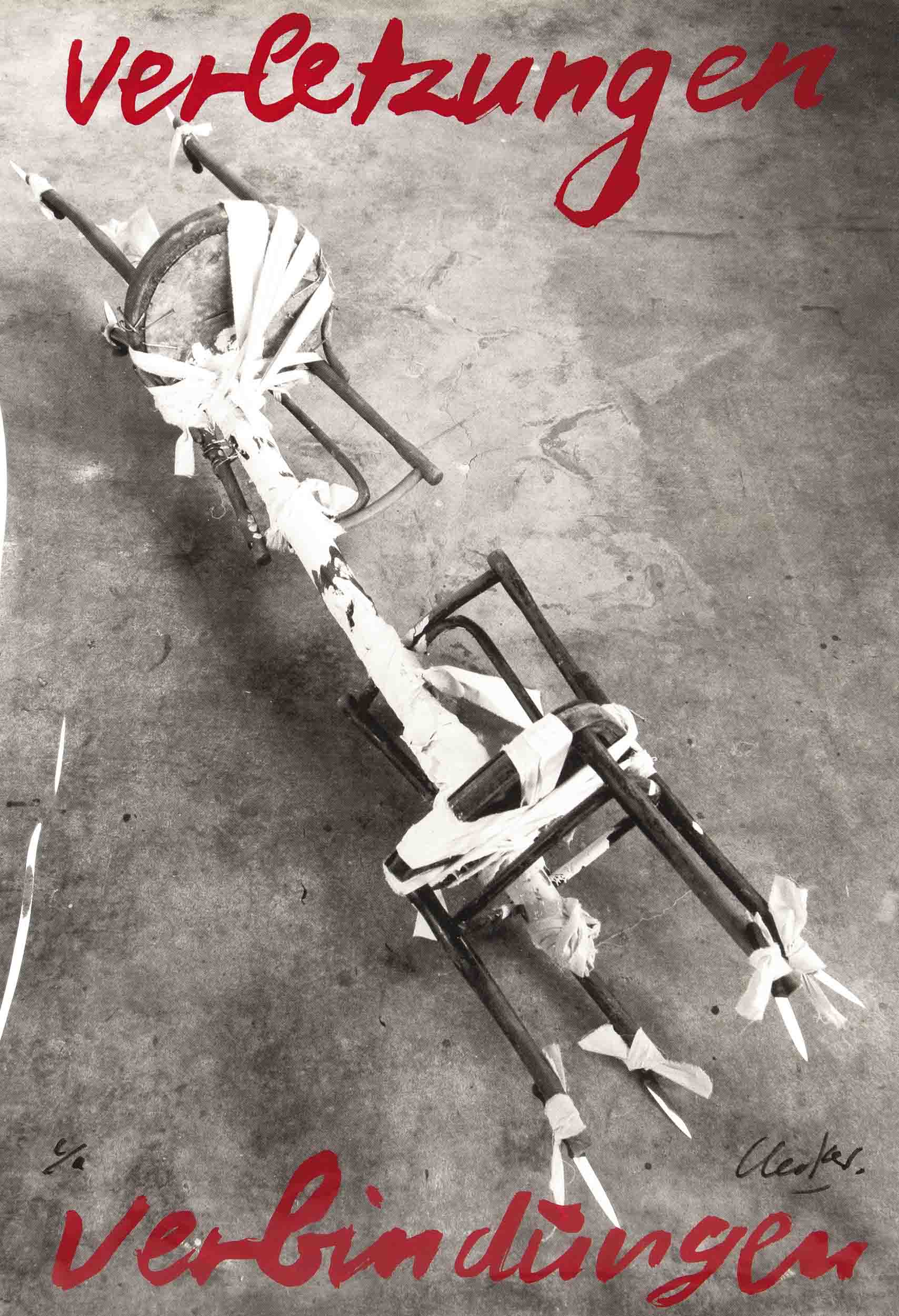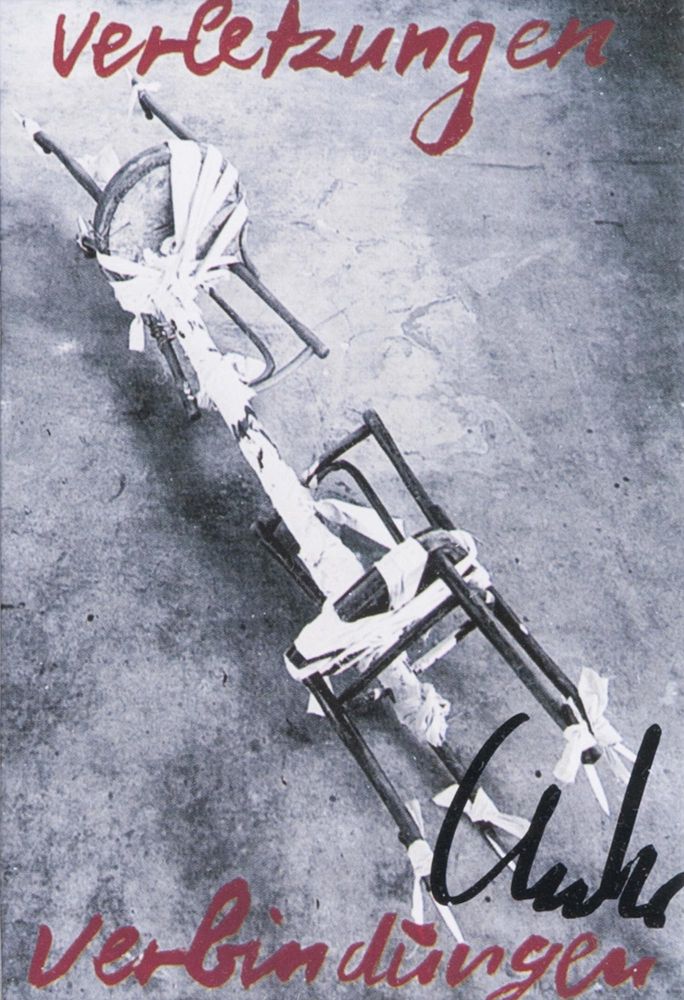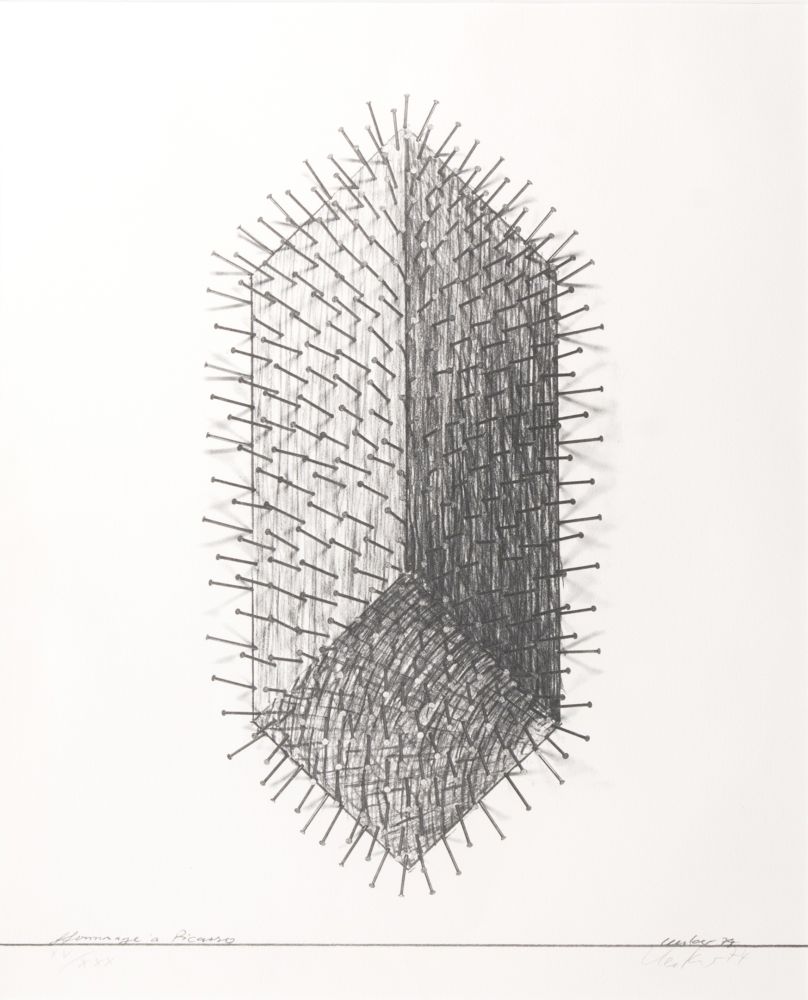Günther Uecker (1930 Wendorf) (F)
'Optische Partitur II', Prägedruck und Lithografie auf Bütten, 66,5 cm x 90 cm Blattmaß, signiert, 014 datiert, 67/100 nummeriert, Edition Stoob Steindruck, St. Gallen (mit Prägestempel), montiert Günther Uecker studierte an der Kunstakademie in Berlin und Düsseldorf. Der Nagel wurde zum kompositorischen Hauptelement seiner Kunst. Mit ihm gelangen symmetrische Formationen, Anordnungen und Rhythmisierungen. Ob dieser direkt ins Holz geschlagen wurde, weiß übertüncht oder wie hier als Instrument für einen Prägedruck genutzt wurde. Das Wort Instrument ist an dieser Stelle gleich mehrdeutig zu denken, da Uecker den Nagel zum einen als handwerkliches Instrument nutzt, um das handgeschöpfte Papier mit gerade dem Druck zu formen, dass es die kreisrund punktuelle Form des Nagelkopfes annimmt. Zum Zweiten, da die Setzung eben dieser punktuellen Notationen an die Notensetzung auf einem Notenblatt erinnert. Taucht man tiefer in die Sinnhaftigkeit des Blattes ein, erscheinen diese Punkte sogar wie eine Blindenschrift und lassen erkennen, dass selbst ein Blinder - der doch keine Kunst zu sehen vermag - sie dennoch mit seinen Sinnen erfühlen oder hören kann. So wie Künstler die Einheit von Form und Farbe und Schönheit zur höchsten Entfaltung bringen können, schaffen es Komponisten eben diese Schönheit in eine Melodie umzusetzen. Gleichsam sollte es möglich sein, wie hier, eine Partitur ins Optische zu übersetzen. Unterstützt wird der Eindruck des klangvoll dynamischen Blattes mit schwungvollen schwarzen Linien.
Günther Uecker (1930 Wendorf) (F)
'Optische Partitur II', relief print and lithograph on handmade paper, 66,5 cm x 90 cm sheet dimension, signed, 014 dated, 67/100 numbered, Edition Stoob Steindruck, St. Gallen (with embossing stamp), mounted Günther Uecker studied at the art academies in Berlin and Düsseldorf. The nail became the main compositional element of his art. It is used to create symmetrical formations, arrangements and rhythms. Whether it was hammered directly into the wood, whitewashed or, as here, used as an instrument for embossed printing. The word instrument is to be thought of ambiguously, since Uecker uses the nail on the one hand as an instrument of craftsmanship to shape the handmade paper with precisely the pressure that makes it take on the circular, punctual form of the nail head. Secondly, because the setting of these punctual notations is reminiscent of the notation on a sheet of music. If you delve deeper into the meaning of the sheet, these dots even appear like braille and make it clear that even a blind person - who is not able to see art - can nevertheless feel or hear it with his senses. Just as artists can bring the unity of form, colour and beauty to the highest development, composers are able to transform this very beauty into a melody. Similarly, it should be possible, as here, to translate a musical score into the visual. The impression of the sonorously dynamic sheet is supported by sweeping black lines.
Günther Uecker (1930 Wendorf) (F)
'Optische Partitur II', Prägedruck und Lithografie auf Bütten, 66,5 cm x 90 cm Blattmaß, signiert, 014 datiert, 67/100 nummeriert, Edition Stoob Steindruck, St. Gallen (mit Prägestempel), montiert Günther Uecker studierte an der Kunstakademie in Berlin und Düsseldorf. Der Nagel wurde zum kompositorischen Hauptelement seiner Kunst. Mit ihm gelangen symmetrische Formationen, Anordnungen und Rhythmisierungen. Ob dieser direkt ins Holz geschlagen wurde, weiß übertüncht oder wie hier als Instrument für einen Prägedruck genutzt wurde. Das Wort Instrument ist an dieser Stelle gleich mehrdeutig zu denken, da Uecker den Nagel zum einen als handwerkliches Instrument nutzt, um das handgeschöpfte Papier mit gerade dem Druck zu formen, dass es die kreisrund punktuelle Form des Nagelkopfes annimmt. Zum Zweiten, da die Setzung eben dieser punktuellen Notationen an die Notensetzung auf einem Notenblatt erinnert. Taucht man tiefer in die Sinnhaftigkeit des Blattes ein, erscheinen diese Punkte sogar wie eine Blindenschrift und lassen erkennen, dass selbst ein Blinder - der doch keine Kunst zu sehen vermag - sie dennoch mit seinen Sinnen erfühlen oder hören kann. So wie Künstler die Einheit von Form und Farbe und Schönheit zur höchsten Entfaltung bringen können, schaffen es Komponisten eben diese Schönheit in eine Melodie umzusetzen. Gleichsam sollte es möglich sein, wie hier, eine Partitur ins Optische zu übersetzen. Unterstützt wird der Eindruck des klangvoll dynamischen Blattes mit schwungvollen schwarzen Linien.
Günther Uecker (1930 Wendorf) (F)
'Optische Partitur II', relief print and lithograph on handmade paper, 66,5 cm x 90 cm sheet dimension, signed, 014 dated, 67/100 numbered, Edition Stoob Steindruck, St. Gallen (with embossing stamp), mounted Günther Uecker studied at the art academies in Berlin and Düsseldorf. The nail became the main compositional element of his art. It is used to create symmetrical formations, arrangements and rhythms. Whether it was hammered directly into the wood, whitewashed or, as here, used as an instrument for embossed printing. The word instrument is to be thought of ambiguously, since Uecker uses the nail on the one hand as an instrument of craftsmanship to shape the handmade paper with precisely the pressure that makes it take on the circular, punctual form of the nail head. Secondly, because the setting of these punctual notations is reminiscent of the notation on a sheet of music. If you delve deeper into the meaning of the sheet, these dots even appear like braille and make it clear that even a blind person - who is not able to see art - can nevertheless feel or hear it with his senses. Just as artists can bring the unity of form, colour and beauty to the highest development, composers are able to transform this very beauty into a melody. Similarly, it should be possible, as here, to translate a musical score into the visual. The impression of the sonorously dynamic sheet is supported by sweeping black lines.















Testen Sie LotSearch und seine Premium-Features 7 Tage - ohne Kosten!
Lassen Sie sich automatisch über neue Objekte in kommenden Auktionen benachrichtigen.
Suchauftrag anlegen